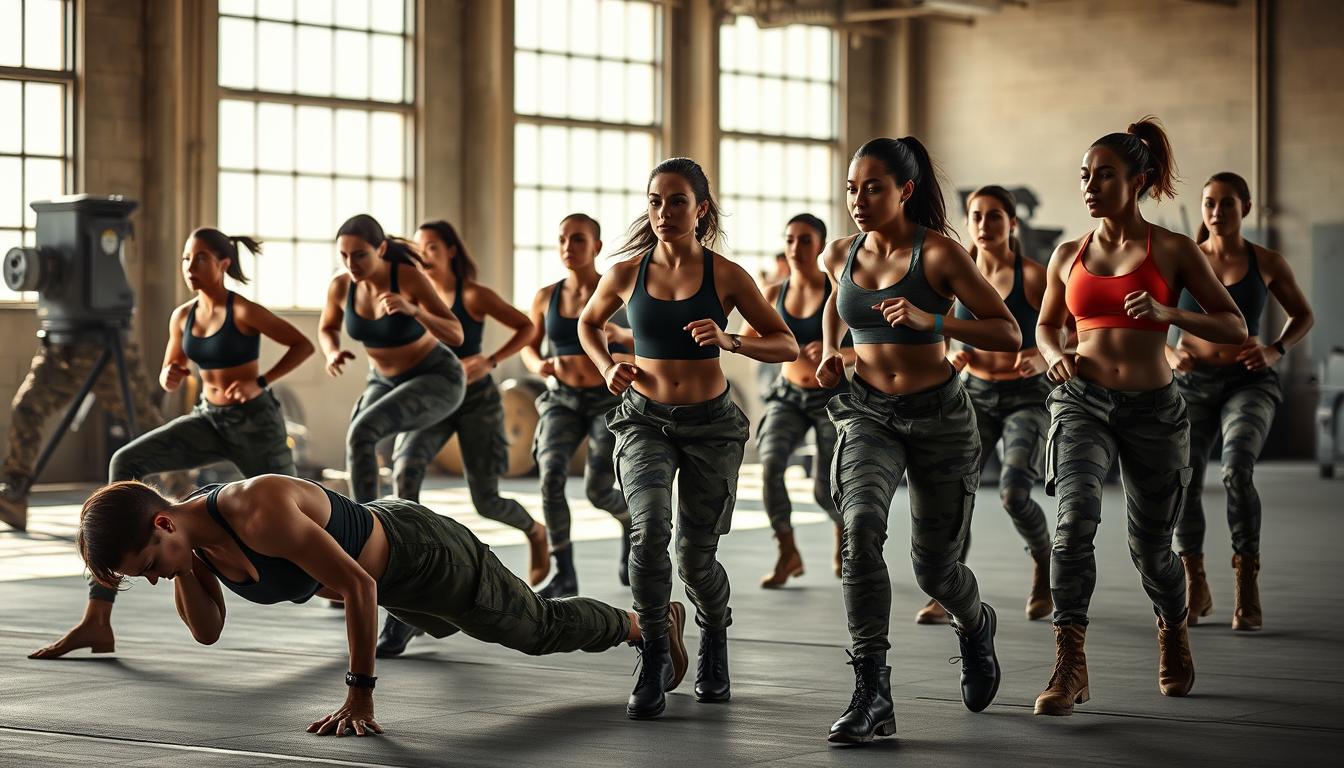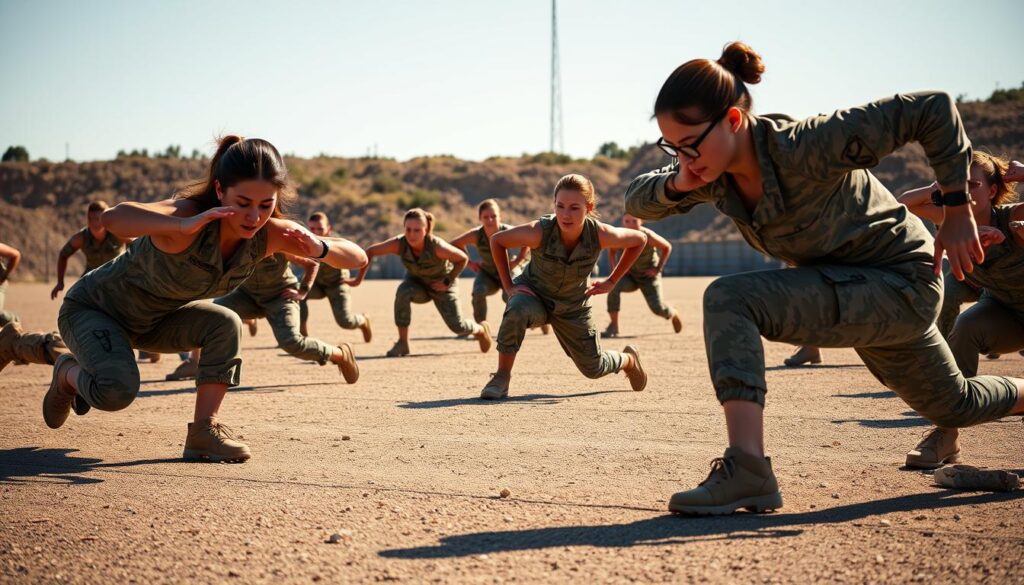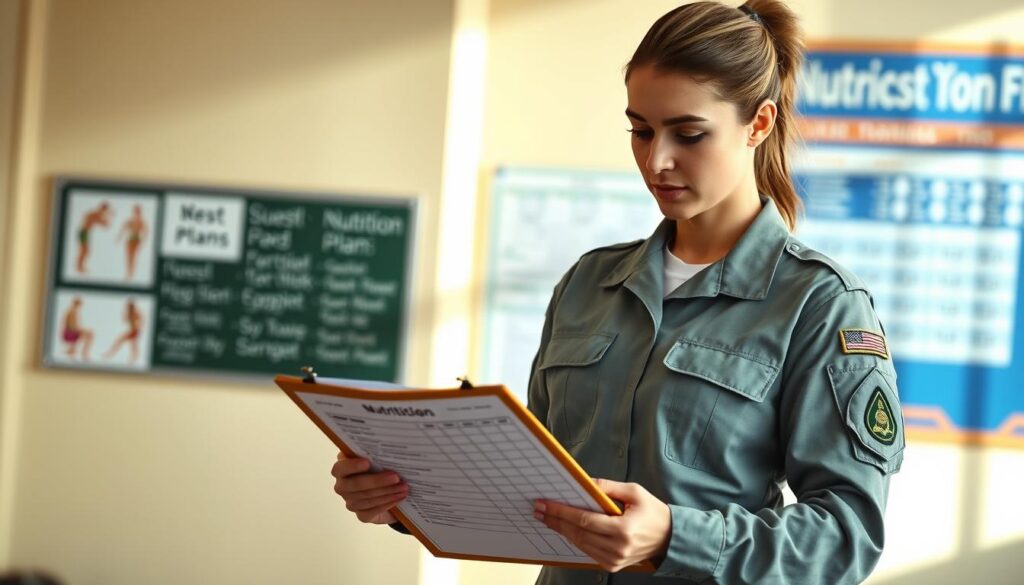The fitness culture in the military is key for a soldier’s readiness and health. For military women, passing tough physical tests is vital for their jobs.
The move from the Army Physical Fitness Test (APFT) to the Army Fitness Test (AFT) marks a big change. It shows how important fitness standards are for soldiers to handle military life.
Key Takeaways
- The Army Fitness Test (AFT) is crucial for assessing military readiness.
- Fitness standards for women are designed to improve physical strength and mental toughness.
- The shift to AFT reflects a focus on combat readiness.
- Fitness testing starts at Basic Training for Soldiers and initial training for Officers.
- The AFT plays a significant role in the Army’s fitness culture.
Overview of Army Female Fitness Standards
The Army sets tough fitness standards for female soldiers. This is key to get them ready for military life. It’s all about physical training.
Importance of Fitness in the Army
Fitness is key for soldiers to do their jobs well. The Army’s fitness test, or APFT, checks their fitness. It looks at push-ups, sit-ups, and a 2-mile run. The Army’s fitness rules make sure soldiers can handle their duties.
Key Components of Fitness:
- Cardiovascular endurance
- Muscular strength and endurance
- Flexibility
Historical Context of Female Standards
Female soldier standards have changed a lot. At first, they were easier, but as women’s roles grew, so did the standards. Now, they’re more challenging.
The Army now sees the big role women play in the military.
Current Trends in Military Fitness
The Army moved from the APFT to the Army Combat Fitness Test (ACFT). The ACFT tests more skills, like the Deadlift and Plank. This change shows the Army’s focus on being ready for combat.
The ACFT aims to be fair and tough for all soldiers. It makes sure everyone is ready for today’s military tasks.
Physical Fitness Test (APFT) Explained
Knowing the APFT is key for any soldier aiming to meet army female fitness assessment criteria. It tests a soldier’s readiness through push-ups, sit-ups, and a 2-mile run.
Components of the APFT
The APFT checks a soldier’s fitness. It has three main parts:
- Push-ups: Shows upper body strength and endurance.
- Sit-ups: Tests core strength and endurance.
- 2-mile run: Checks cardiovascular endurance.
Soldiers must do all three in 2 hours. Each event is scored by how many they do or how fast they run.
Scoring System for Female Soldiers
The APFT scores are set for both men and women. Female scores depend on age. To pass, they need a score of 60 in each event.
“The APFT standards define how soldiers must perform across various fitness test events. These standards cover the minimum and maximum scores for different age groups and genders.”
For female soldiers, the scoring is clear. For example, a 17-21 year old must do at least 19 push-ups, 19 sit-ups, and run the 2-mile in 13:30 minutes or less. This is to score 60 in each event.
| Age Group | Push-ups (min) | Sit-ups (min) | 2-mile Run (min) |
|---|---|---|---|
| 17-21 | 19 | 19 | 13:30 |
| 22-26 | 17 | 17 | 14:00 |
| 27-31 | 15 | 15 | 14:30 |
Comparison to Male Standards
Male and female soldiers do the same APFT events. But, the scores are different. For example, a male 17-21 year old must do at least 42 push-ups, 53 sit-ups, and run the 2-mile in 9:54 minutes or less to score 100 in each event.
It’s important for soldiers to understand these differences. By focusing on their US military female fitness benchmarks, female soldiers can improve their fitness.
Army Combat Fitness Test (ACFT) Introduction
The ACFT is a new way to check if female soldiers are ready for combat. It’s better than the old Army Physical Fitness Test (APFT). This test makes sure soldiers can handle combat better.
The ACFT has changed how female soldiers train and get tested. It has six events that mimic combat. This makes the test more thorough.
New Requirements for Female Soldiers
Female soldiers must now pass the ACFT. It includes deadlifts, hand-release push-ups, and sprint-drag-carry. These tests check strength, endurance, and agility.
“The ACFT is a more realistic assessment of a soldier’s ability to perform in combat,” Army officials say. This change will make female soldiers more ready for combat.
Changes from the APFT to ACFT
The switch from APFT to ACFT is big. The APFT tested push-ups, sit-ups, and a 2-mile run. But the ACFT has more events that are like combat.
- Deadlift: Tests strength and power
- Hand-release push-up: Evaluates upper body strength and endurance
- Sprint-drag-carry: Assesses agility and anaerobic endurance
Importance of the ACFT for Combat Readiness
The ACFT is key for female soldiers to be ready for combat. It checks more physical skills than the APFT. This makes sure soldiers are truly ready for combat.
“The new fitness test is a step in the right direction towards ensuring our soldiers are prepared for the rigors of combat,” said a senior Army officer.
This focus on combat readiness will help female soldiers do better in real missions.
Fitness Training Guidelines for Female Soldiers
Female soldiers need detailed fitness guidelines for military service. Building fitness boosts confidence in meeting Army standards. Tips include pacing, focusing on cardio, strength, endurance, flexibility, and body composition.
Effective Exercises and Workouts
To reach peak performance, female soldiers should do various exercises. This includes:
- Cardiovascular training like running and swimming
- Strength training with weights or bodyweight exercises
- Flexibility and mobility exercises like yoga or stretching
Sample Workout Routine:
| Day | Cardio | Strength Training | Flexibility |
|---|---|---|---|
| Monday | 30 minutes running | Squats, Lunges | Yoga |
| Wednesday | Swimming | Push-ups, Pull-ups | Stretching |
| Friday | Cycling | Deadlifts, Bench Press | Pilates |
Nutrition for Peak Performance
A balanced diet is key for female soldiers. It supports training and recovery. Key nutrition points include:
- Enough protein for muscle repair
- Complex carbs for energy
- Staying hydrated with water
The Role of Resilience and Mental Fortitude
Resilience and mental strength are vital for female soldiers. A strong mental game involves:
- Setting realistic goals and tracking progress
- Practicing mindfulness and stress management
- Building a support network
By focusing on these areas, female soldiers can improve their performance and readiness.
Strategies for Achieving Fitness Standards
To meet the Army’s female fitness assessment criteria, soldiers must use effective strategies. These include setting goals, using resources, and getting support from peers.
Goal Setting and Progress Tracking
Setting clear, achievable goals is key for female soldiers aiming to meet the US military female fitness benchmarks. By setting specific targets, they can plan their fitness journey. Tracking progress helps them see what needs work, so they can adjust their training.
Using a fitness log or mobile app helps track progress. It shows how far they’ve come over time. This keeps them motivated and helps them make better workout choices.
Utilizing Army Resources and Programs
The Army offers many resources to help soldiers reach their fitness goals. These include fitness centers, sports leagues, and outdoor activities on base. Using these resources helps female soldiers mix up their workouts and stay interested.
Joining group fitness classes or sports leagues adds variety and builds camaraderie. The Army’s fitness programs also prepare soldiers for the Army’s fitness tests. This ensures they are well-prepared and ready for combat.
Importance of Peer Support and Team Building
Peer support is vital for a soldier’s fitness journey. Training with others provides moral support and a competitive edge. This pushes individuals to do their best.
Team-building activities, like group workouts or obstacle courses, improve unit cohesion. They create a supportive environment. This collective effort helps soldiers meet and keep up with fitness standards.
Impact of Physical Fitness on Career Advancement
Physical fitness is key for Army career growth, especially for women. Staying fit is not just for passing tests. It’s also vital for moving up in rank.
Being physically fit is essential for a soldier’s success. It helps them do their job well and safely. For women, passing the army female PT test standards is crucial for career growth.
Fitness as a Factor in Promotions
Promotions in the Army depend on many things, like performance and fitness. Being fit can really help a soldier get promoted. For example, doing well on the APFT or ACFT shows dedication and discipline.
Being fit also shows resilience and mental strength. These are qualities the Army values a lot. They can help a soldier stand out when it’s time for promotions.
Physical Standards and Job Assignments
Jobs in the Army often depend on a soldier’s fitness level. Roles that need more physical strength go to those who meet the military women’s fitness requirements.
For example, jobs in special operations or combat units are very demanding. Women who are fit are more likely to get these roles. These jobs are prestigious and can be a big step up in a soldier’s career.
Case Studies of Successful Female Soldiers
Many female soldiers have shown how important fitness is for their careers. One officer, for instance, always scored well on the APFT. She was then chosen for a leadership role in a combat unit.
Her fitness, along with her leadership skills, made her a great choice. This story shows how physical fitness can boost a career for female soldiers.
In summary, fitness is crucial for female soldiers’ career growth. By staying fit and meeting standards, they can improve their career chances and reach their goals in the Army.
Challenges Faced by Female Soldiers
Female soldiers face many challenges as they try to meet Army fitness standards. These can include physical, mental, and personal issues. They also deal with logistical problems.
Addressing Gender-Specific Fitness Concerns
Female soldiers often have unique physical challenges. They have more body fat and less muscle than men. This can make it harder for them to do certain tasks.
The Army has created female soldier physical training guidelines to help. These guidelines focus on exercises that improve fitness. They help female soldiers meet the army female fitness standards.
Balancing Personal and Professional Fitness Goals
Female soldiers have to balance their fitness goals with work demands. Deployments and training can make it hard to stay fit.
To manage this, many set specific goals. They also use Army resources and programs to stay fit.
Overcoming Barriers to Training
Despite resources, female soldiers may still face training barriers. These can include lack of facilities, time, or support.
The Army has started initiatives to help. These include flexible training and support networks. They aim to give all soldiers a chance to meet fitness standards.
| Challenge | Solution |
|---|---|
| Gender-Specific Fitness Concerns | Tailored Training Programs |
| Balancing Personal and Professional Goals | Prioritized Training Schedules |
| Limited Access to Facilities | Flexible Training Initiatives |
By tackling these challenges, the Army can better support its female soldiers. This helps them meet fitness standards and perform better.
“The key to success is not just about meeting the standards but also about maintaining a culture of fitness and resilience among our female soldiers.”
Future of Female Fitness Standards in the Army
The US Army is updating its female fitness standards. This change aims to support the roles of female soldiers better. As the military evolves, so do the fitness goals for soldiers.
Adapting to New Challenges
Future changes in fitness standards will come from data and analysis. The Army plans to update its fitness tests. This will make sure they prepare soldiers well for today’s warfare.
Innovative Training Solutions
New programs and technologies will boost female fitness in the Army. These will make training more personalized. This will help soldiers perform better and be ready for action.
Fostering Inclusion and Diversity
The Army is focusing more on inclusion and diversity in fitness. It’s creating programs for all soldiers. This ensures everyone can meet the fitness standards.



